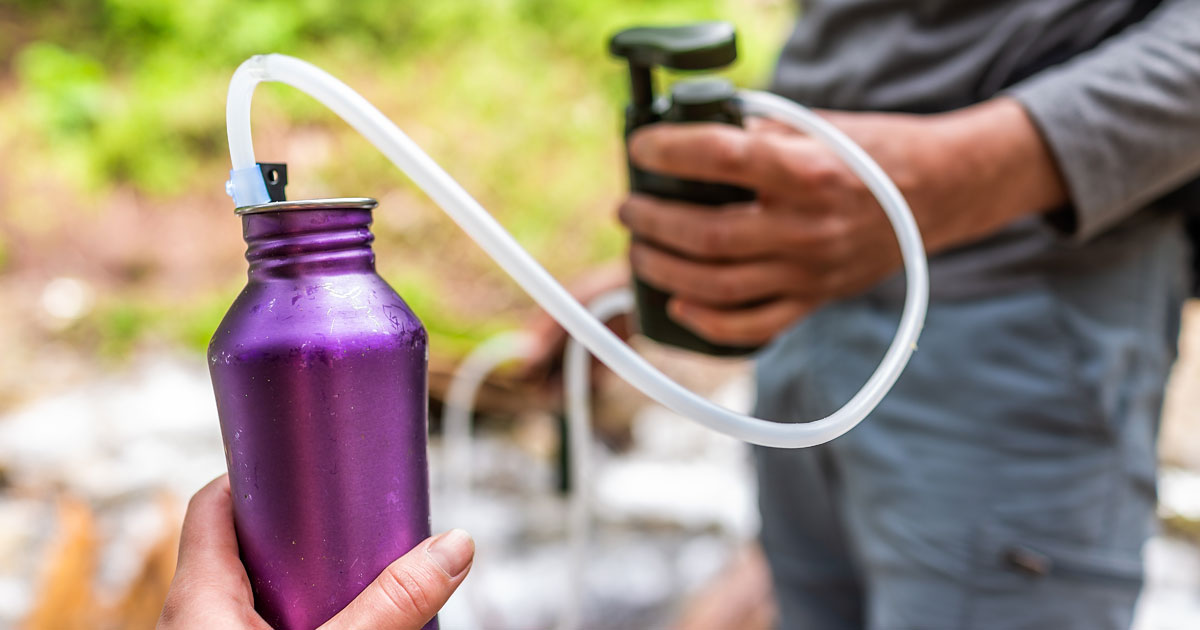How to Make Well Water Safe for Drinking (Expert Guide)
 Andrew
November 26, 2025
#waterquality
#well
#wellwater
#wholehome
Andrew
November 26, 2025
#waterquality
#well
#wellwater
#wholehome

- Well water quality can change over time due to geological conditions, agricultural runoff, and system deterioration, making annual testing for bacteria, nitrates, and pH essential for safety.
- Common well water contaminants include microorganisms, heavy metals like arsenic and lead, chemical compounds, and physical sediment that require different treatment approaches.
- Effective well water treatment typically involves multi-stage systems starting with water softening and sediment filtration, followed by carbon filtration and specialized treatments like UV or reverse osmosis.
- Regular maintenance including filter replacement every 3–12 months and ongoing water testing ensures treatment systems continue protecting your family's health and home infrastructure.
Well water refers to groundwater accessed through one of three main types of wells: dug wells, driven wells, or drilled wells. Historically, many homes relied on dug wells that reached just 10–30 feet into the ground. A driven well involves forcing a pipe through sand or gravel, often to around 30–50 feet. Modern residential wells are typically drilled, often extending hundreds of feet down to access deeper, more reliable aquifers. This depth can provide some natural protection from surface contamination, but it doesn't guarantee water quality.
The fundamental difference between well water and municipal water lies in oversight and treatment. Municipal water systems are required to meet federal standards, with regular testing and treatment before water reaches your tap. Private well water, however, comes directly from the ground to your home without any required treatment or monitoring, making it the owner's responsibility to ensure water safety through a combination of whole-house water filters on the well and other specialized treatment.
Why Well Water Can Be Unsafe
Well water quality can vary significantly based on several factors that every well owner should be aware of:
- Natural geological contamination from rock and soil formations
- Agricultural runoff containing pesticides and fertilizers
- Industrial waste and chemical seepage
- Microbial contamination from septic systems
- Surface water infiltration during flooding
- Changes in local groundwater conditions from development or drilling
- Deterioration of well components over time
Health Risks of Contaminated Well Water
The impact of contaminated well water on health can range from mild to severe, immediate to long-term. Immediate effects can include gastrointestinal issues such as nausea, vomiting, and diarrhea, typically resulting from bacterial contamination. However, the more frightening threats come from long-term exposure to contaminants like arsenic, lead, or nitrates, which can contribute to chronic health conditions.
Children, elderly individuals, pregnant women, and those with compromised immune systems face heightened risks from contaminated water. For instance, nitrate levels that might be harmless to adults can pose serious risks to infants, potentially leading to a condition called blue baby syndrome. This makes regular testing and proper filtration not just a matter of water quality, but of family safety.
How to Test Your Well Water
The Centers for Disease Control and Prevention (CDC) outlines specific recommendations for well water testing frequencies. At minimum, well owners should test their water annually for total coliform bacteria and E. coli, nitrates, total dissolved solids, and pH levels.
However, certain heavy metal contaminants like arsenic, lead, and copper should be tested every 3-5 years. These timeframes should be adjusted based on local conditions and any noticeable changes in water quality, taste, odor, or color.
A comprehensive baseline test from a certified laboratory typically costs between $200–$500, providing detailed analysis of your water's composition. While this might seem expensive, it's essential for designing an effective filtration system. Individual contaminant tests range from $20–$150, making it feasible to monitor specific concerns between comprehensive tests.

When it comes to well water contamination, understanding what you're dealing with is the first step toward effective treatment. Here are the primary categories of contaminants typically found in well water:
- Microorganisms such as coliform bacteria, E. coli, Giardia, and Cryptosporidium
- Inorganic compounds including arsenic, lead, copper, nitrates, iron, and manganese
- Organic compounds like pesticides, herbicides, volatile organic compounds (VOCs), and petroleum products
- Radiological elements including radon, uranium, and radium
- Physical contaminants such as sediment, sand, and organic material
Prevention is often more effective—and less expensive—than treatment when it comes to well water quality. The first line of defense is proper well construction and maintenance. A properly constructed well includes features like a watertight cap, surface seals, and adequate casing height above ground level to prevent surface water from entering the well. Regular inspection of these components can catch potential problems before they affect your water quality.
Location plays a crucial role in prevention. Your well should maintain adequate distance from potential contamination sources like septic systems, livestock areas, or chemical storage. This setback distance varies by state and local regulations, but generally ranges from 50 to 100 feet. Even with proper setbacks, it's important to be mindful of activities near your well that could impact groundwater quality, such as fertilizer application or use of deicing salts.
Unused wells pose a particular risk to groundwater quality. These abandoned wells can act as direct conduits for surface contamination to reach groundwater if not properly sealed. If you have an unused well on your property, professional abandonment is essential for protecting your active well's water quality.
Determining exactly how to filter well water starts with understanding your specific water quality challenges. A comprehensive water test provides the foundation for this decision, revealing which contaminants need to be addressed. While it might be tempting to install a basic system and hope for the best, this approach often leads to inadequate treatment or unnecessary expense.
Modern well water treatment typically involves a multi-stage approach, with each component addressing specific water quality issues. The initial investment for a complete system can range from $1,000 to $4,500 or more, depending on your water quality needs and home size. But this cost should be weighed against the long-term benefits of protected health, preserved plumbing, and improved water quality.
Water Softeners: The Foundation of Many Systems
For many well owners, a water softener serves as the foundation of their treatment system. Hard water, common in well systems, contains high levels of calcium and magnesium that can damage plumbing, reduce appliance efficiency, and affect water heater performance. A properly sized water softener, typically costing between $800 and $2,500 installed, can significantly extend the life of your plumbing and appliances while improving water quality for cleaning and bathing.
Water softener maintenance primarily involves replenishing salt every 6-8 weeks, with bags typically costing $5-$25 each. While this represents an ongoing cost, the protection provided to your plumbing system and appliances often results in significant long-term savings.
Whole-House Filtration Systems
Building on the foundation of water softening, whole-house filtration systems provide comprehensive water treatment for all points of use in your home. These systems typically start with sediment filtration to remove particles that could damage downstream treatment components. The size and micron rating of sediment filters depend on your specific water conditions, with options ranging from 50 micron pre-filters down to 5 micron final filters.
Following sediment removal, carbon filtration addresses chemical contaminants, improving taste and odor while removing chlorine, pesticides, and many organic compounds. The size of these systems varies based on household water usage and contamination levels. While a small home might be adequately served by 2.5" by 10" cartridges, most homes require 4.5"x 10" or 4.5" x 20" cartridges (often called "Big Blue" housing referring to the Pentek brand) to properly filter while maintaining adequate water pressure and flow rates.

For wells with specific contamination challenges, additional treatment methods may be necessary. UV systems, priced between $500 and $1,500, provide effective protection against bacteria and other microorganisms without adding chemicals to your water. These systems require annual lamp replacement and regular cleaning but offer reliable disinfection when properly maintained.
Reverse osmosis (RO) systems offer the most comprehensive water treatment but come with higher costs and maintenance requirements. While point-of-use RO systems for drinking water typically cost $200-$600, in rare cases customers may install a costlier whole-house RO system for $2,000 to $4,000 or more. The increased cost is in part due to the need to regulate water pressure because RO membranes can filter down to 0.001 micron and smaller, resulting in a pressure drop that would result in insufficient flow to a household without a booster pump. RO systems excel at removing dissolved contaminants but require regular pre-filter and membrane replacement.
A well water treatment system is an investment that requires regular maintenance to perform effectively. Rather than waiting for problems to develop, establishing a regular maintenance schedule helps ensure consistent water quality and can prevent costly repairs.
Filter replacement schedules vary based on water quality and usage, but typically follow these general guidelines: sediment pre-filters every 3–6 months, carbon filters every 6–12 months, and RO membranes every 2–3 years. However, these intervals should be adjusted based on your specific water quality and monitoring of system performance. Many homeowners make a habit of changing all their filters on a regular schedule, such as annually, if water quality allows.
Water testing remains important even after installing treatment systems. Annual testing for basic parameters helps verify that your system is performing as intended and can alert you to any changes in raw water quality that might require treatment adjustments. More comprehensive testing every 3–5 years provides a thorough evaluation of your water quality and treatment effectiveness.

When selecting treatment components, certification provides assurance of performance and safety. NSF International and ANSI have established key standards for water treatment equipment, including NSF/ANSI 42 for aesthetic effects and NSF/ANSI 53 for health effects. However, it's important to understand that multiple organizations can certify products to these standards, including IAPMO and the Water Quality Association, and many filters are not certified at all, per industry norms.
The certification landscape can be confusing, with some manufacturers making misleading claims about their certifications. Always verify certifications through the certifying organization's database and be wary of vague certification claims. A legitimate certification will specify exactly which contaminants the system is certified to remove and under what conditions.
Installing a whole-house water filters on the well represents a significant investment in your family's health and your home's infrastructure. While the initial costs and ongoing maintenance requirements may seem daunting, the importance of safe, clean water makes proper treatment essential for well owners. By understanding your water quality, choosing appropriate treatment methods, and maintaining your system properly, you can ensure reliable access to clean, safe water for years to come.
Remember that water quality can change over time due to factors beyond your control. Regular testing, proper maintenance, and understanding your specific water quality challenges remain essential even after installing treatment systems. Working with qualified professionals for testing and system design, while staying informed about your water quality through regular monitoring, provides the best protection for your well water system.






